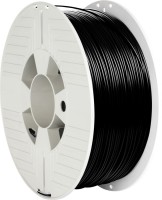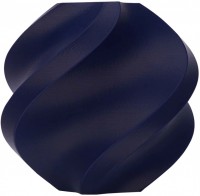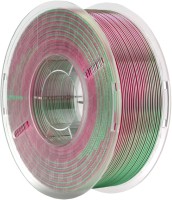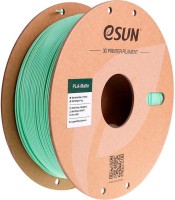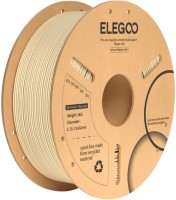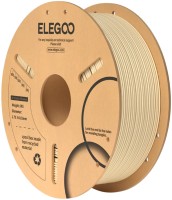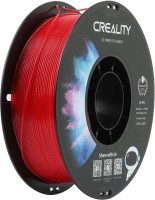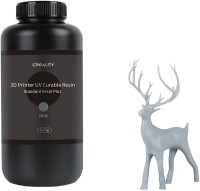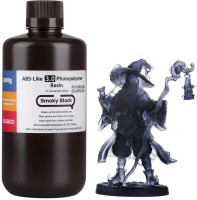Різновиди пластику для 3D-друку
Ми незалежно перевіряємо товари та технології, які рекомендуємо.

1. Порівняння поширених типів філамента для 3D-друку
| Пластик | Температура плавлення, °C | Міцність | Гнучкість | Термостійкість, °C | Складність використання |
|---|---|---|---|---|---|
| ABS | 220 – 250 | висока | середня | 90 – 100 | середня |
| ABS+ | 230 – 260 | висока | середня | 90 – 110 | середня |
| PLA | 180 – 220 | середня | низька | 55 – 60 | дуже низька |
| PLA+ | 200 – 230 | середня | низька | 60 – 65 | низька |
| HIPS | 230 – 260 | висока | низька | 90 – 100 | середня |
| ASA | 230 – 260 | висока | середня | 100 – 110 | середня |
| PETG | 230 – 250 | висока | середня | 70 – 80 | низька |
| PCTG | 230 – 260 | висока | середня | 75 – 85 | низька |
| TPU | 210 – 250 | середня | висока | 60 – 80 | висока |
| TPE | 220 – 260 | низька | дуже висока | 50 – 70 | висока |
| TPR | 230 – 270 | середня | дуже висока | 50 – 70 | висока |
| Nylon | 250 – 300 | висока | середня | 100 – 120 | висока |
| Flex | 190 – 260 | середня | висока | 80 – 100 | висока |
| BVOH | 210 – 220 | низька | низька | 40 – 50 | низька |
| Фотополімери | UV-затвердіння | висока | низька | 60 – 80 | середня |
Детальніше про всі поширені різновиди пластиків для 3D-друку розповідається нижче.
2. Гід по ключовим типам 3D-пластиків
2.1. ABS/ABS+
Пластик ABS оточує нас повсюдно — з нього виготовляються найрізноманітніші товари: канцелярське приладдя, чохли для мобільних телефонів, дитячі іграшки, конструктори і багато іншого. У розрізі 3D-друку ABS-філамент також отримав широке поширення. Матеріал акрилонітрил-бутадієн-стирол характеризується високою міцністю і ударостійкістю, не боїться впливу вологи і відрізняється хорошою довговічністю. Поверхня ABS-пластика виходить глянцевою, він непрозорий і може мати будь-який колір. Температурний діапазон експлуатації виробів з цього пластика становить від -40 °C до +90 °C, а то і більше.
Температура плавлення ABS-пластика знаходиться в межах 220 – 250 °C. А оскільки матеріал схильний до деформації і усадки при охолодженні, під час друку бажано використовувати підігрівану платформу. Уникнення впливу температурних перепадів з таким пластиком часто працюють на принтерах з закритими камерами. З інших нюансів філамента ABS відзначається чутливість до прямого сонячного світла, а також неприємний і їдкий запах у процесі 3D-друку. Втім, остання проблема вирішується належним провітрюванням приміщення. А ось використовувати обдування під час друку цим пластиком не рекомендується — пам'ятаємо, що матеріал може деформуватися і тріскатися при охолодженні.

Деякі недоліки оригінальної технології ABS усунені у вдосконаленій формулі пластика ABS+. Конкретні особливості таких філаментів залежать від виробника — одні склади позиціонуються як більш пружні і менш схильні до деформацій у порівнянні зі звичайним ABS, інші — більш стійкі до впливу прямих сонячних променів. Ці подробиці в кожному випадку варто з'ясовувати окремо.
2.2. PLA/PLA+
Полілактид PLA належить до розряду «натуральних» матеріалів з екологічно чистої сировини. Цей 3D-пластик виготовляється з кукурудзяного крохмалю або цукрової тростини, є біорозкладаним, не виділяє їдких запахів і шкідливих речовин при нагріванні. Для друку PLA-пластиком знадобиться температура екструдера близько 180 – 220 °C, до того ж матеріал практично не прилипає до поверхні друкарського столу. Це як перевага, так і недолік одночасно — в процесі друку може знадобитися додавання кайми і клею на поверхню столу або знадобиться використовувати текстуровану пластину PEI.
Філамент PLA підходить для друку декоративних виробів, прототипів і моделей, які не потребують високої міцності або термостійкості. Проте матеріал досить крихкий — його не рекомендується використовувати для створення деталей, які потенційно будуть піддаватися механічним навантаженням. Ще один помітний недолік PLA-пластика — вище згадана біорозкладаність, що зменшує довговічність виробів з нього.
Покращені модифікації пластика PLA+ містять у своєму складі спеціальні добавки, які надають друкованому матеріалу додаткові властивості: покращену міжшарову адгезію, відмінне спікання шарів, високу міцність на розрив і на згин, зменшену механічну крихкість. Конкретна формула добавок може варіюватися в залежності від сорту пластика і виробника сировини. В залежності від заданих властивостей, варіюється і температура плавлення пластика PLA+ — як правило, вона знаходиться в діапазоні від 200 °C до 230 °C.
2.3. HIPS
Ударостійкий полістирол High Impact Polystyrene може застосовуватися як основний матеріал для 3D-друку, так і в якості підтримок при створенні складних моделей — HIPS-пластик легко розчиняється в лімонені. За властивостями філамент являє собою щось середнє між пластиками ABS і PLA. Він поєднує високу міцність і гнучкість, витримує високі ударні навантаження, легко піддається постобробці.
Температура плавлення матеріалу знаходиться в межах 230 – 260 °C. HIPS-пластик не виявляє токсичних властивостей, вироби з нього не бояться вологи, є надійними і довговічними. При друці HIPS може продукувати токсичні випаровування.
2.4. ASA
Термопластик Acrylonitrile Styrene Acrylate позиціонується в ролі поліпшеного замінника ABS-філаментів зі стійкістю до атмосферних впливів. Насамперед, цей різновид пластика проявляє відмінну стійкість до ультрафіолетового випромінювання — вироби з філамента ASA можна довго використовувати на відкритому повітрі під палючими сонячними променями. Разом з тим матеріал володіє високою ударною в'язкістю, легко витримує механічні впливи, піддається різним способам постобробки.

Пластик плавиться при температурах від 230 °C до 260 °C. За його покращені характеристики передбачена відповідна плата — ASA-філамент обходиться на порядок дорожче традиційного ABS-термопластика.
2.5. TPU/TPE/TPR
Група еластичних термопластиків для 3D-друку гнучких і пружних деталей. Термопластичний поліуретан TPU має температуру екструзії до 250 °C. За тактильними відчуттями готові вироби з цього пластика нагадують взуттєву підошву. Власне, з нього і можуть виготовлятися підошви для взуття, а також чохли для мобільних пристроїв, різні ущільнювачі, прокладки і т.п. До того ж термополіуретан характеризується хімічною стійкістю до бензину, автомасел, спирту та інших розчинників.
Філамент TPE (термопластичний еластомер) поєднує властивості пластика і гуми. Матеріал служить для створення гнучких і пружних деталей, які можуть деформуватися під тиском і повертатися до вихідної форми. Максимальна температура його плавлення досягає 260 °C. TPE-пластик досить складний в обігу і вимагає повільної швидкості друку, а його висока адгезія викликає налипання до сопла.
Нарешті, термопластична гума TPR відрізняється високою стійкістю до зносу і посиленою механічною міцністю в порівнянні з вищезазначеними TPU і TPE. Пластик має температуру екструзії від 230 до 270 °C.
2.6. PETG/PCTG
PETG — це поліпшена різновид поліетиленового філамента PET. Символом «G» в його абревіатурі позначаються гліколеві добавки для зниження крихкості і спрощення 3D-друку. Матеріал поєднує міцні характеристики ABS-пластика і універсальність застосування PLA-філамента. Температура друку PETG становить 230 – 250 °C.

Пластик має хорошу міжшарову адгезію, примітний стійкістю до механічних впливів і хімічних речовин, дає низьку усадку і деформацію. Філамент підходить для виготовлення харчових контейнерів. За вартістю PETG часто обходиться дешевше інших термопластиків. Головний недолік матеріалу — його гігроскопічність, тобто здатність вбирати і накопичувати вологу. Тому важливо дотримуватися сухих умов для правильного зберігання цього термопластика.
2.7. Nylon
PA-пластик або нейлон застосовується у сфері 3D-друку відносно недавно, через що зустрічається рідше інших філаментів. Nylon використовують для створення деталей, які зазнають постійні механічні навантаження: шестерень, рухомих з'єднань і механізмів. З ключових особливостей пластика виділяються стійкість до стирання, довговічність і зносостійкість. Також матеріал витримує високі температури експлуатації і має відмінну міцність на розрив.
Каменем спотикання на шляху до широкого використання нейлону є складність в обігу. Термопластик вимагає високих температур плавлення (до 300 °C), виділяє чимало шкідливих речовин і схильний поглинати вологу з повітря. Для роботи з нейлоном необхідний належний досвід і закрита камера друку, однак отримані результати перевершують очікування завдяки механічній міцності і довговічності готових виробів.
2.8. Flex
Flex у перекладі з англійської означає «гнучкий». Відповідно, цей пластик і служить для друку гнучких або еластичних виробів. За властивостями він максимально близький до твердого силікону — Flex-філамент не боїться ударів і впливу агресивних рідин (типу масел і бензину), проявляє зносостійкість і довговічність.

Готові вироби з Flex-пластика витримують робочу температуру приблизно до 100 °C. Сам же філамент має температуру екструзії 190 – 260 °C — в залежності від конкретного сорту. Пластик застосовується для виготовлення різноманітних ущільнювачів, прокладок, демпферів, ремінців, антиковзних накладок і елементів.
2.9. BVOH
Один з популярних різновидів допоміжного пластика для 3D-друку. BVOH — абревіатура від Butenediol Vinyl Alcohol Copolymer (сополімер бутендіолу і полівінілового спирту). Філамент легко розчиняється у звичайній теплій воді, а використовувати його передбачається в якості підтримок при створенні складних багатокомпонентних моделей. Опорні елементи з BVOH-пластика допомагають зберегти геометрію «роздруковуваної» конструкції без пошкодження основної структури виробу.
Матеріал поєднується з популярними термопластиками ABS, PLA, PETG і Nylon. Оптимальною температурою екструзії для цього філамента є діапазон від 210 до 220 °C.
2.10. Фотополімери
Полімерні матеріали в рідкій формі, що тверднуть під дією ультрафіолету. Ключова особливість фотополімерів — вони не вимагають нагріву для використання. Однак і застосовуються ці філаменти в специфічних різновидах 3D-принтерів з друком за технологіями SLA, DLP, MJM. Існує велике різноманіття таких матеріалів, які відрізняються за характеристиками в'язкості, швидкості застигання, чутливості до світла та практичними особливостями (затверділа смола може мати властивості різних матеріалів).

Фотополімери дозволяють досягати високої швидкості друку, однак обходяться вони значно дорожче традиційних термопластиків.
3. Відповіді на часто задавані питання
3.1. Який пластик найкраще підходить для новачків?
Найбільш зручним і передбачуваним філаментом для осягнення азів 3D-друку послужить пластик типу PLA. Також досить прості в обігу термопластики PETG, що забезпечують виготовлення більш міцних виробів.
3.2. Який пластик використати для гнучких деталей?
Для створення гнучких деталей підійдуть філаменти групи TPU, TPE і TPR — фактично вони мають властивості пластику та гуми. Сюди ж відносяться термопластики типу Flex, апріорі спрямовані на виготовлення еластичних деталей.
3.3. Як зберігати 3D-пластик?
Різні пластики вимагають різних умов зберігання. Якщо ж говорити узагальнено, найкраще для зберігання підходять пластикові або скляні контейнери з герметично закриваючоюся кришкою. Розміщувати їх передбачається при кімнатній температурі поза зоною доступу прямих сонячних променів, щоб запобігти руйнуванню структури пластику і вигоранню кольору. Гігроскопічні філаменти (PETG, Nylon) необхідно берегти від вологи — їх бажано упаковувати у вакуумні пакети або використовувати для відведення зайвої вологи силікагель. І, звісно, тримайте термопластик у чистоті.
3.4. Чи можна комбінувати різні пластики в одному виробі?
Комбінування термопластиків — розповсюджена практика в області 3D-друку. Яскравим тому прикладом є використання допоміжного водорозчинного філамента типу BVOH, який апріорі розрахований на створення тимчасових підтримок для компонентів основної конструкції виробу. Можуть поєднуватися і інші типи пластиків для створення різних фактур об'єкта (наприклад, комбінація прозорих і непрозорих філаментів, жорстких і гнучких елементів).

Зазначимо, що термопластики різняться температурою плавлення і швидкістю подачі з сопла — це вимагає відповідного налаштування друкарського обладнання. Також різні матеріали можуть погано зчіплюватися один з одним. Так, умовний PLA-філамент погано тримається разом з пластиками ABS або Nylon.
3.5. Який пластик витримує високі температури?
За температурою плавлення найбільшого нагрівання вимагає Nylon — приблизно до 300 °C. Він же володіє високою термостійкістю — готові вироби з цього пластика розраховані на експлуатацію при температурах до 120 °C. Температури до 100 °C спокійно витримує філамент Flex, а до 110 °C — пластик ASA.
3.6. Чому пластик тріскається або деформується під час друку?
Причини цього можуть бути різними. Найпоширеніша з таких — велика різниця температур між шарами екструдованого пластику, що формує напругу в моделі. Проблема частково вирішується використанням підігріваного столу. Тріщини також виникають через недостатню температуру екструдера і надмірного охолодження виробу.
До деформацій ведуть занадто низька або надто висока швидкість подачі філамента, нестабільність подачі матеріалу через нерівномірний діаметр нитки, високий процент вмісту вологи в 3D-пластику.
3.7. Чи можна друкувати пластиковими відходами?
Цілком допустимо, але з певними застереженнями. Справа в тому, що 3D-пластики піддаються термічній деградації — нагрівання потенційно погіршує їх властивості. Фізична деградація погіршується при повторних циклах нагрівання і загартування філамента. Для пом'якшення проблеми в формулу перероблених ниток для 3D-принтерів додається певний процент первинного пластику. Таким чином вдається досягти властивостей, суміжних з новим матеріалом.

На ринку представлені 3D-пластики з вторсировини від виробників Reflow, ReFuel і Filamentive. Втім, філамент можна переробляти самостійно — для цього знадобиться обзавестися системами подрібнення пластику та екструдера нитки. Якість 3D-друку з вторсировини багато в чому залежить від налаштувань, умов друку і обладнання, на якому був виготовлений пластик.
3.8. Який пластик підходить для друку шестерень або механічних деталей?
Для цих цілей найкраще підходять різновиди термопластику Nylon і PETG / PCTG. Однак два останніх варіанта підійдуть для виготовлення шестерень або механічних деталей, які зазнають відносно невеликі навантаження.
3.9. Як дізнатися, яка температура потрібна для мого пластику?
Оптимальна температура плавлення зазвичай вказується на пакуванні з філаментом. А загалом температурні рамки екструзії для популярних різновидів 3D-пластика наочно представлені у таблиці вище (на початку статті).
3.10. Чому мої вироби виглядають неакуратно (провисання, нитки, шорсткості)?
Провисання ниток обумовлюються занадто гарячою температурою екструдера, надто високою швидкістю друку та не використанням підтримок.
Нитками філамент тягнеться теж через високу температуру сопла або ж внаслідок повільної швидкості друку.
Шорсткості і нерівності поверхонь виникають через погане спікання шарів і неправильних налаштувань подачі друкованого матеріалу.


























